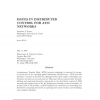Free Online Productivity Tools
i2Speak
i2Symbol
i2OCR
iTex2Img
iWeb2Print
iWeb2Shot
i2Type
iPdf2Split
iPdf2Merge
i2Bopomofo
i2Arabic
i2Style
i2Image
i2PDF
iLatex2Rtf
Sci2ools
151
click to vote
PODC
1995
ACM
1995
ACM
Issues in Distributed Control for ATM Networks
Asynchronous Transfer Mode (ATM) network technology is expected to become a central part of the emerging global information infrastructure. ATM networks introduce a number of features that distinguish them from earlier technologies and introduce new issues in network control. This paper o ers a framework for precisely de ning and analyzing alternative approaches to the distributed control of ATM networks and explores some of the key design issues through a series of examples. It is hoped that it will provide a useful foundation for researchers in networking and distributed computing interested in exploring these issues further and developing more complete solutions. 0 This work was supported by the ARPA Computing Systems Technology O ce, Ascom Timeplex, Bay Networks, Bell Northern Research, NEC, NTT, Southwestern Bell and Tektronix.
Asynchronous Transfer Mode | ATM Networks | Distributed And Parallel Computing | Global Information Infrastructure | PODC 1995 |
Related Content
| Added | 26 Aug 2010 |
| Updated | 26 Aug 2010 |
| Type | Conference |
| Year | 1995 |
| Where | PODC |
| Authors | Jonathan S. Turner |
Comments (0)

